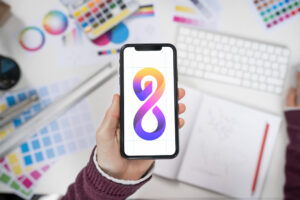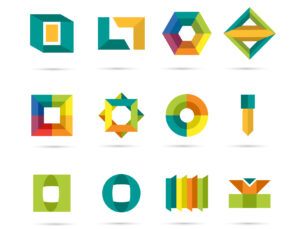Storytelling Through Logo Design: How to Build a Brand’s Identity in a Single Icon
In today’s visually driven world, a brand’s logo often serves as the first point of contact between a business and its audience. It’s not just a design, but a powerful storytelling tool that can convey a company’s mission, values, and personality in a single glance. A well-crafted logo has the potential to tell a brand’s story without a single word, leaving a lasting impression and building a connection with consumers.
But what makes a logo more than just a symbol? How does it transform into an identity that tells a story? In this blog, we will explore the key elements of storytelling through logo design and how brands can use this tool to their advantage.

1. The Power of Simplicity
One of the most important aspects of a good logo is simplicity. A logo that is overly complicated or busy can be hard to recognize and remember. Simplicity allows for clarity, which is essential for conveying a brand’s core message quickly and effectively.
When a logo is simple, it becomes more versatile, able to be scaled and adapted across various platforms and mediums. It’s no surprise that some of the world’s most iconic brands—like Nike, Apple, and McDonald’s—have logos that are simple yet instantly recognizable.
Example:
Take the Nike swoosh, for example. This simple, curved check mark symbolizes movement, speed, and athletic achievement. Without the need for words, the logo tells the story of a brand that’s all about performance, competition, and success.

2. Symbolism: Hidden Meanings in Logos
Great logos often include subtle symbols or hidden meanings that go beyond the obvious. These visual elements may not be noticed at first glance, but when discovered, they add depth to the brand’s identity and make it more memorable. These symbols can evoke emotions, reinforce the brand’s values, or highlight the brand’s mission.
Example:
The FedEx logo is famous for its hidden arrow between the letters “E” and “x.” This clever use of negative space subtly communicates the company’s focus on precision and speed in delivering packages. The hidden message gives the logo an extra layer of meaning, making it more than just a wordmark—it becomes a symbol of reliability.

3. Reflecting Brand Values and Personality
A logo is not just a design; it’s a reflection of what the brand stands for. Every element, from color to shape, should be carefully considered to ensure it aligns with the brand’s values and personality. Whether the brand is fun and playful, serious and professional, or innovative and cutting-edge, the logo should visually represent these characteristics.
Example:
Take the colorful and playful logo of Google. The use of primary colors reflects the brand’s approachable and fun personality, while the clean, sans-serif font gives it a modern and innovative feel. Google’s logo is a great example of how a brand’s identity can be reflected in its design choices, from color to typography.

4. The Importance of Versatility
A good logo needs to be versatile enough to work across various platforms and mediums. It should look just as good on a business card as it does on a billboard or a smartphone screen. This is why simplicity is so crucial—an overly complex logo might not be effective in smaller sizes or on different backgrounds.
Versatility also means the logo can adapt to different uses without losing its impact. It might be presented in color or black and white, with or without a tagline, and still maintain its recognizability.
Example:
Think of the Apple logo. Whether it’s in color, black and white, or embossed on a product, the simple apple shape with the bite out of it is always instantly recognizable. Its versatility is one of the reasons the brand is so powerful.

5. Creating a Lasting First Impression
In the crowded marketplace, a logo often serves as the first impression of a brand. It can determine whether a potential customer takes the next step to learn more about the company or moves on. A logo that is visually appealing and meaningful can create curiosity and draw in the audience.
However, it’s not just about attracting attention; it’s about creating a lasting impression. A well-designed logo can leave a mark in the minds of consumers, making them more likely to remember the brand and engage with it in the future.
Example:
Coca-Cola’s script logo has stood the test of time for over a century, in part because of the strong first impression it creates. The flowing, elegant design suggests happiness and timelessness, which aligns with the brand’s goal of bringing joy to people’s lives. It’s instantly recognizable and memorable, helping the brand maintain its iconic status.

6. Balancing Tradition and Innovation
For brands that have been around for a long time, the challenge often lies in balancing tradition with modernity. While a logo must evolve to stay relevant in a changing market, it’s also important to maintain some elements of the original design to preserve the brand’s heritage.
Many brands opt for subtle updates over time, tweaking their logos to make them feel fresh without losing their identity. This evolution shows that a brand can grow while staying true to its roots.
Example:
The Starbucks logo has gone through several redesigns over the years, but it has always maintained its iconic mermaid figure. The most recent iteration removed the wordmark entirely, allowing the symbol alone to represent the brand. This evolution shows confidence in the power of their visual identity while modernizing it for a global audience.

7. Tips for Designing a Storytelling Logo
When creating a logo that tells a brand’s story, keep the following tips in mind:
- Know Your Brand’s Story: Before designing, be clear about what your brand stands for, its values, and the message you want to communicate. This will guide your design decisions.
- Keep it Simple: The best logos are simple, clean, and easy to recognize. Avoid adding too many elements that could clutter the design or confuse the message.
- Use Symbolism: Incorporate symbols or shapes that subtly convey your brand’s values, mission, or unique selling points.
- Choose Colors Wisely: Colors evoke emotions and have psychological impacts. Choose a color palette that aligns with your brand’s personality and resonates with your target audience.
- Test for Versatility: Ensure your logo works well in various sizes, colors, and formats. A versatile logo will be easier to use across different mediums.
Conclusion
A logo is much more than just a visual mark; it’s a brand’s identity condensed into a single symbol. Through careful use of simplicity, symbolism, and versatility, a logo can tell the story of a brand, leaving a lasting impression and forging a connection with consumers. By understanding how to craft a logo that reflects a brand’s mission, values, and personality, businesses can create a powerful storytelling tool that speaks volumes without saying a word. For Mark Studio, this storytelling through design is the key to creating brands that resonate and stand the test of time.





